Magic Items and Item Identification
About this tutorial
This tutorial is free and open source, and all code uses the MIT license - so you are free to do with it as you like. My hope is that you will enjoy the tutorial, and make great games!
If you enjoy this and would like me to keep writing, please consider supporting my Patreon.
Magical items are a mainstay of both D&D and roguelikes. From the humble "Sword +1", to mighty "Holy Avenger" - and back again to "Cursed Backbiter" - items helped to define the genre. In roguelikes, it's also traditional to not automatically know what items are; you find an "Unidentified Longsword", and have no idea what it does (or if is cursed) until you find a way to identify it. You find a "Scroll of cat walked on keyboard" (the unpronounceable names seem to be a feature!), and until you identify or read it - you don't know what to expect. Some games turn this into entire meta-games - gambling on frequency, vendor prices and similar to give you clues as to what you just found. Even Diablo, the most mainstream roguelike (even if it went real-time!) of them all has retained this play feature - but tends to make Identify scrolls extremely plentiful (as well as helpful old Scotsmen).
Classes of magic item
It's common in modern games to differentiate magic items as being magical, rare or legendary (along with item sets, which we won't go into yet). These are typically differentiated by color, so you can tell at a glance if an item is even worth considering. This also gives an opportunity to denote that something is a magic item - so we'll open up components.rs (and register in main.rs and saveload_system.rs) and make MagicItem:
#![allow(unused)] fn main() { #[derive(Debug, Serialize, Deserialize, Clone, Eq, PartialEq, Hash)] pub enum MagicItemClass { Common, Rare, Legendary } #[derive(Component, Debug, Serialize, Deserialize, Clone)] pub struct MagicItem { pub class : MagicItemClass } }
The next step is to let items be denoted as magical, and having one of these classes. Add the following to raws/item_structs.rs:
#![allow(unused)] fn main() { #[derive(Deserialize, Debug)] pub struct Item { pub name : String, pub renderable : Option<Renderable>, pub consumable : Option<Consumable>, pub weapon : Option<Weapon>, pub wearable : Option<Wearable>, pub initiative_penalty : Option<f32>, pub weight_lbs : Option<f32>, pub base_value : Option<f32>, pub vendor_category : Option<String>, pub magic : Option<MagicItem> } #[derive(Deserialize, Debug)] pub struct MagicItem { pub class: String } }
Why are we using a full struct here, rather than just a string? We're going to want to specify more information here later in the chapter as we start to flesh out magical items.
You can now decorate items in spawns.json, for example:
{
"name" : "Health Potion",
"renderable": {
"glyph" : "!",
"fg" : "#FF00FF",
"bg" : "#000000",
"order" : 2
},
"consumable" : {
"effects" : { "provides_healing" : "8" }
},
"weight_lbs" : 0.5,
"base_value" : 50.0,
"vendor_category" : "alchemy",
"magic" : { "class" : "common" }
},
I've added the common magic tag to the magical scrolls and potions already in the JSON list, see the source for details - it's pretty straightforward at this point. Next up, we need to modify spawn_named_item in raws/rawmaster.rs to apply the appropriate component tags:
#![allow(unused)] fn main() { if let Some(magic) = &item_template.magic { let class = match magic.class.as_str() { "rare" => MagicItemClass::Rare, "legendary" => MagicItemClass::Legendary, _ => MagicItemClass::Common }; eb = eb.with(MagicItem{ class }); } }
Now that we have this data, we need to use it. For now, we'll just want to set the display color of item names whenever they appear in the GUI - to give a better idea of magic item value (just like all those MMO games!). In gui.rs, we'll make a generic function for this purpose:
#![allow(unused)] fn main() { pub fn get_item_color(ecs : &World, item : Entity) -> RGB { if let Some(magic) = ecs.read_storage::<MagicItem>().get(item) { match magic.class { MagicItemClass::Common => return RGB::from_f32(0.5, 1.0, 0.5), MagicItemClass::Rare => return RGB::from_f32(0.0, 1.0, 1.0), MagicItemClass::Legendary => return RGB::from_f32(0.71, 0.15, 0.93) } } RGB::from_f32(1.0, 1.0, 1.0) } }
Now we need to go through all of the functions in gui.rs that display an item name, and replace the hard-coded color with a call to this function. In draw_ui (line 121 of gui.rs), expand the equipped list a little:
#![allow(unused)] fn main() { // Equipped let mut y = 13; let entities = ecs.entities(); let equipped = ecs.read_storage::<Equipped>(); let name = ecs.read_storage::<Name>(); for (entity, equipped_by, item_name) in (&entities, &equipped, &name).join() { if equipped_by.owner == *player_entity { ctx.print_color(50, y, get_item_color(ecs, entity), black, &item_name.name); y += 1; } } }
The same change in the consumables section:
#![allow(unused)] fn main() { ctx.print_color(53, y, get_item_color(ecs, entity), black, &item_name.name); }
We're going to leave tooltips alone, improving them (and the log) are the subject of a (currently hypothetical) future chapter. In show_inventory (around line 321), drop_item_menu (around line 373), remove_item_menu (around line 417), and vendor_sell_menu (around line 660):
#![allow(unused)] fn main() { ctx.print_color(21, y, get_item_color(&gs.ecs, entity), RGB::from_f32(0.0, 0.0, 0.0), &name.name.to_string()); }
Be warned: these lines will change again once we add item identification!
With that in place, if you cargo run you will see your Town Portal Scroll is now nicely highlighted as a common magical item:
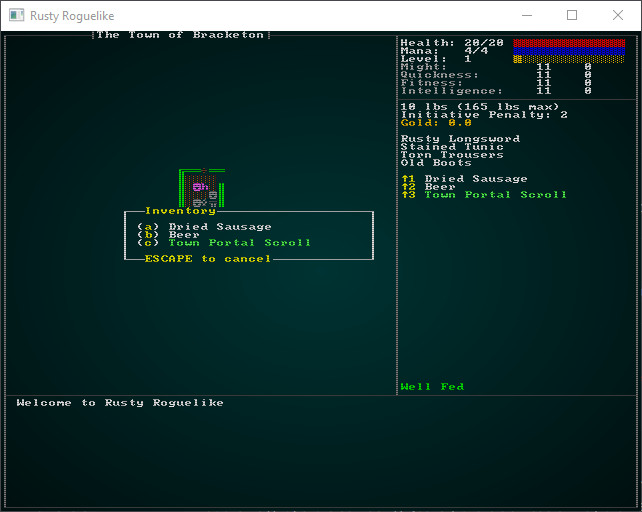
Identification: Scrolls
It's pretty common in Roguelikes for potions to have thoroughly unpronounceable names when you don't know what they do. Presumably, this represents some sort of guttural utterings that trigger the magical effect (and as much fun as it would be to build a giant grammar around this, the tutorial would be even bigger!). So a Scroll of Lorem Ipsum might be any of the scrolls in the game, and it's up to you to decide to identify by using it (a gamble, it may not be what you want at all!), get it identified, or just ignore it because you don't like the risk.
Let's start by opening up spawner.rs, going to the player function and removing the line that gives a free Town Portal. It's overly generous, and would mean you'd have to start knowing what it is!
So here's the fun part: if we were to simply assign an unidentified name to scrolls, players could simply learn the names - and identification would be little more than a memory game. So we need to assign the names when the game starts (and not when the raw files load, since you may play more than once per session). Let's start in raws/item_structs.rs and add another field to MagicItem indicating that "this is a scroll, and should use scroll naming."
#![allow(unused)] fn main() { #[derive(Deserialize, Debug)] pub struct MagicItem { pub class: String, pub naming: String } }
Now we have to go through spawns.json and add naming tags to our "magic" entries. I've opted for "scroll" for naming scrolls (and left the others as empty strings for now). For example, here's the magic missile scroll:
{
"name" : "Magic Missile Scroll",
"renderable": {
"glyph" : ")",
"fg" : "#00FFFF",
"bg" : "#000000",
"order" : 2
},
"consumable" : {
"effects" : {
"ranged" : "6",
"damage" : "20"
}
},
"weight_lbs" : 0.5,
"base_value" : 50.0,
"vendor_category" : "alchemy",
"magic" : { "class" : "common", "naming" : "scroll" }
},
We already have a structure that persists through the whole game (but remains a global resource), and resets whenever we change level: the MasterDungeonMap. It makes some sense to use this to store state about the whole game, since it's already the dungeon master! We're also already serializing it, which helps a lot! So we'll open up map/dungeon.rs and add in a couple of structures:
#![allow(unused)] fn main() { #[derive(Default, Serialize, Deserialize, Clone)] pub struct MasterDungeonMap { maps : HashMap<i32, Map>, identified_items : HashSet<String>, scroll_mappings : HashMap<String, String> } }
We also have to update the constructor to provide empty values (for now):
#![allow(unused)] fn main() { impl MasterDungeonMap { pub fn new() -> MasterDungeonMap { MasterDungeonMap{ maps: HashMap::new() , pub identified_items : HashSet::new(), pub scroll_mappings : HashMap::new() } } }
The idea is that when an item is identified, we'll put its name tag into identified_items, providing a fast way to tell if an item has been identified yet. scroll_mappings is intended to map the actual name of a scroll with a randomized name. These will then persist for the duration of the game session (and be included in save games, automatically!). In order to populate the scroll mappings, we need a way to get hold of the item names tagged as scrolls in the raw files. So in raws/rawmaster.rs, we'll make a new function:
#![allow(unused)] fn main() { pub fn get_scroll_tags() -> Vec<String> { let raws = &super::RAWS.lock().unwrap(); let mut result = Vec::new(); for item in raws.raws.items.iter() { if let Some(magic) = &item.magic { if &magic.naming == "scroll" { result.push(item.name.clone()); } } } result } }
This obtains access to the global raws, iterates through all items looking for magical items that have the scroll naming convention, and returns the names as a vector of strings. We won't be doing it often, so we won't try and be clever with performance (cloning all those strings is a little on the slow side). So now in map/dungeon.rs we further extend the constructor to make scroll name mappings:
#![allow(unused)] fn main() { impl MasterDungeonMap { pub fn new() -> MasterDungeonMap { let mut dm = MasterDungeonMap{ maps: HashMap::new() , identified_items : HashSet::new(), scroll_mappings : HashMap::new() }; let mut rng = rltk::RandomNumberGenerator::new(); for scroll_tag in crate::raws::get_scroll_tags().iter() { let masked_name = make_scroll_name(&mut rng); dm.scroll_mappings.insert(scroll_tag.to_string(), masked_name); } dm } }
This references a new function, make_scroll_name which looks like this:
#![allow(unused)] fn main() { fn make_scroll_name(rng: &mut rltk::RandomNumberGenerator) -> String { let length = 4 + rng.roll_dice(1, 4); let mut name = "Scroll of ".to_string(); for i in 0..length { if i % 2 == 0 { name += match rng.roll_dice(1, 5) { 1 => "a", 2 => "e", 3 => "i", 4 => "o", _ => "u" } } else { name += match rng.roll_dice(1, 21) { 1 => "b", 2 => "c", 3 => "d", 4 => "f", 5 => "g", 6 => "h", 7 => "j", 8 => "k", 9 => "l", 10 => "m", 11 => "n", 12 => "p", 13 => "q", 14 => "r", 15 => "s", 16 => "t", 17 => "v", 18 => "w", 19 => "x", 20 => "y", _ => "z" } } } name } }
This function starts with the stem "Scroll of ", and then adds random letters. Every other letter is a vowel, with consonants in-between. This gets you nonsense, but it's pronounceable nonsense such as iladi or omuruxo. It doesn't give any clue as to the nature of the underlying scroll.
Next, we need a way to denote that an entity has an obfuscated name. We'll make a new component for this task, so in components.rs (and register in main.rs and saveload_system.rs) we add:
#![allow(unused)] fn main() { #[derive(Component, Debug, Serialize, Deserialize, Clone)] pub struct ObfuscatedName { pub name : String } }
We'll also need to add these tags when we spawn an item, so in raws/rawmaster.rs we add the following to spawn_named_item. First, up at the top, we copy the name mapping (to avoid borrowing problems):
#![allow(unused)] fn main() { let item_template = &raws.raws.items[raws.item_index[key]]; let scroll_names = ecs.fetch::<crate::map::MasterDungeonMap>().scroll_mappings.clone(); let mut eb = ecs.create_entity().marked::<SimpleMarker<SerializeMe>>(); }
Then we extend the magic handler:
#![allow(unused)] fn main() { if let Some(magic) = &item_template.magic { let class = match magic.class.as_str() { "rare" => MagicItemClass::Rare, "legendary" => MagicItemClass::Legendary, _ => MagicItemClass::Common }; eb = eb.with(MagicItem{ class }); #[allow(clippy::single_match)] // To stop Clippy whining until we add more match magic.naming.as_str() { "scroll" => { eb = eb.with(ObfuscatedName{ name : scroll_names[&item_template.name].clone() }); } _ => {} } } }
Now, we return to gui.rs and make a new function to obtain an item's display name:
#![allow(unused)] fn main() { pub fn get_item_display_name(ecs: &World, item : Entity) -> String { if let Some(name) = ecs.read_storage::<Name>().get(item) { if ecs.read_storage::<MagicItem>().get(item).is_some() { let dm = ecs.fetch::<crate::map::MasterDungeonMap>(); if dm.identified_items.contains(&name.name) { name.name.clone() } else if let Some(obfuscated) = ecs.read_storage::<ObfuscatedName>().get(item) { obfuscated.name.clone() } else { "Unidentified magic item".to_string() } } else { name.name.clone() } } else { "Nameless item (bug)".to_string() } } }
And once again, we need to go through all the places in gui.rs that reference an item's name and change them to use this function. In draw_ui, this actually shortens some code since we don't need the actual Name component anymore:
#![allow(unused)] fn main() { // Equipped let mut y = 13; let entities = ecs.entities(); let equipped = ecs.read_storage::<Equipped>(); for (entity, equipped_by) in (&entities, &equipped).join() { if equipped_by.owner == *player_entity { ctx.print_color(50, y, get_item_color(ecs, entity), black, &get_item_display_name(ecs, entity)); y += 1; } } // Consumables y += 1; let yellow = RGB::named(rltk::YELLOW); let consumables = ecs.read_storage::<Consumable>(); let backpack = ecs.read_storage::<InBackpack>(); let mut index = 1; for (entity, carried_by, _consumable) in (&entities, &backpack, &consumables).join() { if carried_by.owner == *player_entity && index < 10 { ctx.print_color(50, y, yellow, black, &format!("↑{}", index)); ctx.print_color(53, y, get_item_color(ecs, entity), black, &get_item_display_name(ecs, entity)); y += 1; index += 1; } } }
Once again, we're going to worry about tooltips later (although we will tweak them later to not reveal the actual identity of an object!). The other ones we changed earlier change to ctx.print_color(21, y, get_item_color(&gs.ecs, entity), RGB::from_f32(0.0, 0.0, 0.0), &get_item_display_name(&gs.ecs, entity));, and can trim out some of the name components also.
Once that's done, if you cargo run the project scrolls you find will display obfuscated names:
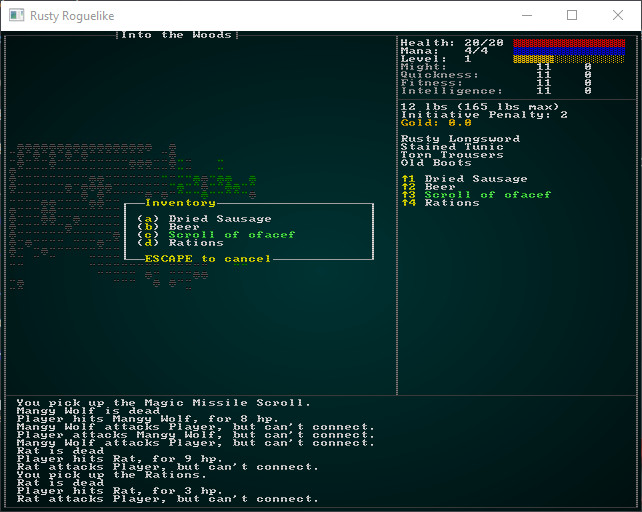
Identifying obfuscated scrolls
Now that we're properly hiding them, lets introduce a mechanism for identifying scrolls. The most obvious is if you use a scroll, it should be identified - and all existing/future instances of that scroll type become identified. The identified_items list handles the future, but we'll have to do some extra work to handle the existing ones. We're going to have quite a few potential identifications occur - when you use an identify magic (eventually), when you use or equip an item, when you buy one (since you know you are buying a Magic Mapping scroll, it makes sense that you identify it) - and probably more as we progress.
We'll handle this with a new component to indicate that an item may have been identified, and a system to process the data. First, in components.rs (and register in main.rs and saveload_system.rs):
#![allow(unused)] fn main() { #[derive(Component, Debug, Serialize, Deserialize, Clone)] pub struct IdentifiedItem { pub name : String } }
Now we'll go to the various places we already have that can identify an item, and attach this component to the player when they use an item. First, extend inventory_system.rs to be able to write to the appropriate storage:
#![allow(unused)] fn main() { impl<'a> System<'a> for ItemUseSystem { #[allow(clippy::type_complexity)] type SystemData = ( ReadExpect<'a, Entity>, WriteExpect<'a, GameLog>, WriteExpect<'a, Map>, Entities<'a>, WriteStorage<'a, WantsToUseItem>, ReadStorage<'a, Name>, ReadStorage<'a, Consumable>, ReadStorage<'a, ProvidesHealing>, ReadStorage<'a, InflictsDamage>, WriteStorage<'a, Pools>, WriteStorage<'a, SufferDamage>, ReadStorage<'a, AreaOfEffect>, WriteStorage<'a, Confusion>, ReadStorage<'a, Equippable>, WriteStorage<'a, Equipped>, WriteStorage<'a, InBackpack>, WriteExpect<'a, ParticleBuilder>, ReadStorage<'a, Position>, ReadStorage<'a, ProvidesFood>, WriteStorage<'a, HungerClock>, ReadStorage<'a, MagicMapper>, WriteExpect<'a, RunState>, WriteStorage<'a, EquipmentChanged>, ReadStorage<'a, TownPortal>, WriteStorage<'a, IdentifiedItem> ); #[allow(clippy::cognitive_complexity)] fn run(&mut self, data : Self::SystemData) { let (player_entity, mut gamelog, map, entities, mut wants_use, names, consumables, healing, inflict_damage, mut combat_stats, mut suffer_damage, aoe, mut confused, equippable, mut equipped, mut backpack, mut particle_builder, positions, provides_food, mut hunger_clocks, magic_mapper, mut runstate, mut dirty, town_portal, mut identified_item) = data; ... }
Then, after targeting (line 113):
#![allow(unused)] fn main() { // Identify if entity == *player_entity { identified_item.insert(entity, IdentifiedItem{ name: names.get(useitem.item).unwrap().name.clone() }) .expect("Unable to insert"); } }
Also, in main.rs where we handle spawning items that were purchased we should identify those, also:
#![allow(unused)] fn main() { gui::VendorResult::Buy => { let tag = result.2.unwrap(); let price = result.3.unwrap(); let mut pools = self.ecs.write_storage::<Pools>(); let player_entity = self.ecs.fetch::<Entity>(); let mut identified = self.ecs.write_storage::<IdentifiedItem>(); identified.insert(*player_entity, IdentifiedItem{ name : tag.clone() }).expect("Unable to insert"); std::mem::drop(identified); let player_pools = pools.get_mut(*player_entity).unwrap(); std::mem::drop(player_entity); if player_pools.gold >= price { player_pools.gold -= price; std::mem::drop(pools); let player_entity = *self.ecs.fetch::<Entity>(); crate::raws::spawn_named_item(&RAWS.lock().unwrap(), &mut self.ecs, &tag, SpawnType::Carried{ by: player_entity }); } } }
Now that we're adding the components, we need to read them and do something with the knowledge!
We need one more helper function in raws/rawmaster.rs to help this process:
#![allow(unused)] fn main() { pub fn is_tag_magic(tag : &str) -> bool { let raws = &super::RAWS.lock().unwrap(); if raws.item_index.contains_key(tag) { let item_template = &raws.raws.items[raws.item_index[tag]]; item_template.magic.is_some() } else { false } } }
Since identifying items is purely an inventory matter, we'll add another system into the already-large inventory_system.rs (spot the hint that we're going to make it into a module, one day?):
#![allow(unused)] fn main() { pub struct ItemIdentificationSystem {} impl<'a> System<'a> for ItemIdentificationSystem { #[allow(clippy::type_complexity)] type SystemData = ( ReadStorage<'a, crate::components::Player>, WriteStorage<'a, IdentifiedItem>, WriteExpect<'a, crate::map::MasterDungeonMap>, ReadStorage<'a, Item>, ReadStorage<'a, Name>, WriteStorage<'a, ObfuscatedName>, Entities<'a> ); fn run(&mut self, data : Self::SystemData) { let (player, mut identified, mut dm, items, names, mut obfuscated_names, entities) = data; for (_p, id) in (&player, &identified).join() { if !dm.identified_items.contains(&id.name) && crate::raws::is_tag_magic(&id.name) { dm.identified_items.insert(id.name.clone()); for (entity, _item, name) in (&entities, &items, &names).join() { if name.name == id.name { obfuscated_names.remove(entity); } } } } // Clean up identified.clear(); } } }
We'll also want to modify spawn_named_item in raws/rawmaster.rs to not obfuscate names of items we already recognize. We'll start by also obtaining an identified item list:
#![allow(unused)] fn main() { let dm = ecs.fetch::<crate::map::MasterDungeonMap>(); let scroll_names = dm.scroll_mappings.clone(); let identified = dm.identified_items.clone(); std::mem::drop(dm); }
Then we'll make name obfuscation conditional upon now knowing what the item is:
#![allow(unused)] fn main() { if !identified.contains(&item_template.name) { #[allow(clippy::single_match)] // To stop Clippy whining until we add more match magic.naming.as_str() { "scroll" => { eb = eb.with(ObfuscatedName{ name : scroll_names[&item_template.name].clone() }); } _ => {} } } }
Finally, we'll add it to run_systems in main.rs:
#![allow(unused)] fn main() { let mut item_id = inventory_system::ItemIdentificationSystem{}; item_id.run_now(&self.ecs); }
So if you cargo run now, you'll be able to identify items by using or buying them.
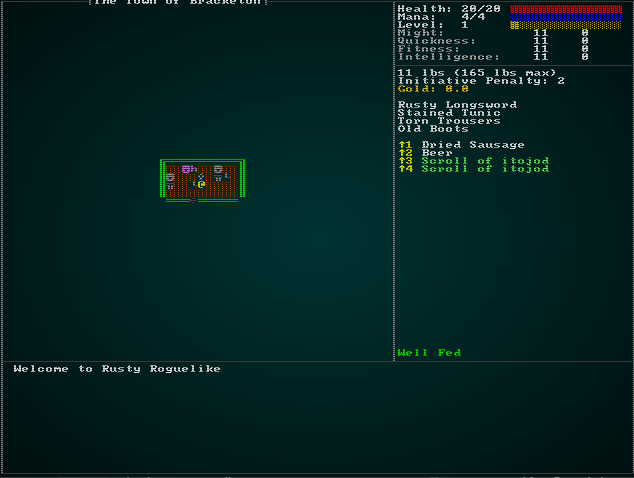
Obfuscating Potions
We can use a very similar setup for potions, but we need to think about how they are named. Typically, potions combine some adjectives with the word potion: "viscous black potion", "swirling green potion", etc. Fortunately, we've now built a lot of the infrastructure framework - so it's a matter of plugging the details in.
We'll start by opening spawns.json, and annotating our health potion with the naming convention "potion":
"items" : [
{
"name" : "Health Potion",
"renderable": {
"glyph" : "!",
"fg" : "#FF00FF",
"bg" : "#000000",
"order" : 2
},
"consumable" : {
"effects" : { "provides_healing" : "8" }
},
"weight_lbs" : 0.5,
"base_value" : 50.0,
"vendor_category" : "alchemy",
"magic" : { "class" : "common", "naming" : "potion" }
},
...
Then, in raws/rawmaster.rs we'll repeat the get_scroll_tags functionality - but for potions. We want to retrieve all items with a "potion" naming scheme - we'll need it to generate potion names. Here's the new function:
#![allow(unused)] fn main() { pub fn get_potion_tags() -> Vec<String> { let raws = &super::RAWS.lock().unwrap(); let mut result = Vec::new(); for item in raws.raws.items.iter() { if let Some(magic) = &item.magic { if &magic.naming == "potion" { result.push(item.name.clone()); } } } result } }
Now we'll revisit map/dungeon.rs and visit the MasterDungeonMap. We need to add a structure for storing potion names (and add it to the constructor). It'll be just like the scroll mapping:
#![allow(unused)] fn main() { #[derive(Default, Serialize, Deserialize, Clone)] pub struct MasterDungeonMap { maps : HashMap<i32, Map>, pub identified_items : HashSet<String>, pub scroll_mappings : HashMap<String, String>, pub potion_mappings : HashMap<String, String> } impl MasterDungeonMap { pub fn new() -> MasterDungeonMap { let mut dm = MasterDungeonMap{ maps: HashMap::new() , identified_items : HashSet::new(), scroll_mappings : HashMap::new(), potion_mappings : HashMap::new() }; ... }
Now, underneath the make_scroll_name function we're going to define some arrays of string constants. These represent the available descriptors for potions; you can (and should!) add/edit these to fit the game you want to make:
#![allow(unused)] fn main() { const POTION_COLORS: &[&str] = &["Red", "Orange", "Yellow", "Green", "Brown", "Indigo", "Violet"]; const POTION_ADJECTIVES : &[&str] = &["Swirling", "Effervescent", "Slimey", "Oiley", "Viscous", "Smelly", "Glowing"]; }
We'll also need a function to combine these to make names, including duplicate checking (to ensure that we never have two potion types with the same name):
#![allow(unused)] fn main() { fn make_potion_name(rng: &mut rltk::RandomNumberGenerator, used_names : &mut HashSet<String>) -> String { loop { let mut name : String = POTION_ADJECTIVES[rng.roll_dice(1, POTION_ADJECTIVES.len() as i32) as usize -1].to_string(); name += " "; name += POTION_COLORS[rng.roll_dice(1, POTION_COLORS.len() as i32) as usize -1]; name += " Potion"; if !used_names.contains(&name) { used_names.insert(name.clone()); return name; } } } }
Then in the MasterDungeonMap constructor, we repeat the scroll logic - but with our new naming scheme, and HashSet to avoid duplicated names:
#![allow(unused)] fn main() { let mut used_potion_names : HashSet<String> = HashSet::new(); for potion_tag in crate::raws::get_potion_tags().iter() { let masked_name = make_potion_name(&mut rng, &mut used_potion_names); dm.potion_mappings.insert(potion_tag.to_string(), masked_name); } }
That gives us a nice random set of names; in the test I just ran, Health Potion's obfuscated name was Slimey Violet Potion. Doesn't sound delicious!
The last thing we need to do is to add an ObfuscatedName component to potion spawns. In raws/rawmaster.rs, we already did this for scrolls - so we duplicate the functionality for potions:
#![allow(unused)] fn main() { let scroll_names = dm.scroll_mappings.clone(); let potion_names = dm.potion_mappings.clone(); ... if !identified.contains(&item_template.name) { match magic.naming.as_str() { "scroll" => { eb = eb.with(ObfuscatedName{ name : scroll_names[&item_template.name].clone() }); } "potion" => { eb = eb.with(ObfuscatedName{ name: potion_names[&item_template.name].clone() }); } _ => {} } } }
We've done all the remaining hard work! So now if you cargo run, walk around and find a potion, you will find it has an obfuscated name:
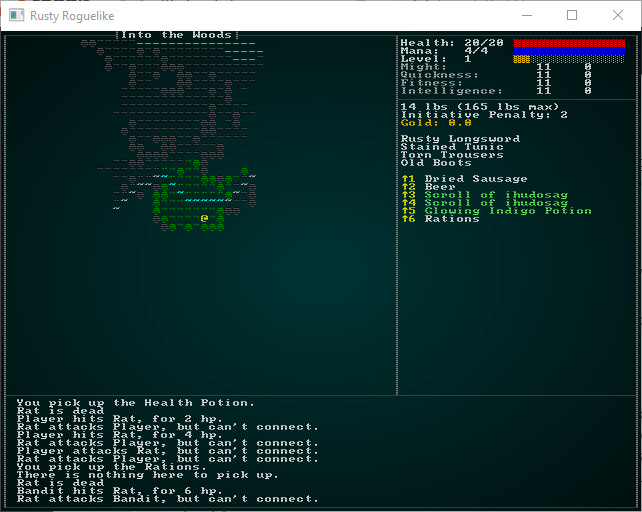
Other magic items
We should also support other magical items, without a special naming scheme. Let's open up spawns.json and define a magical Longsword +1 and give it a generic name in the naming scheme:
{
"name" : "Longsword +1",
"renderable": {
"glyph" : "/",
"fg" : "#FFAAFF",
"bg" : "#000000",
"order" : 2
},
"weapon" : {
"range" : "melee",
"attribute" : "might",
"base_damage" : "1d8+1",
"hit_bonus" : 1
},
"weight_lbs" : 2.0,
"base_value" : 100.0,
"initiative_penalty" : 1,
"vendor_category" : "weapon",
"magic" : { "class" : "common", "naming" : "Unidentified Longsword" }
},
See how we've adjusted the stats to reflect its magical status? It hits more frequently, does more damage, weighs less, is worth more gold and has less of an initiative penalty. That'd be a good find! We should also add it to the spawn table; we'll give it a stupidly high likelihood of appearing for now, so we can test it:
{ "name" : "Longsword +1", "weight" : 100, "min_depth" : 3, "max_depth" : 100 },
We aren't generating any new names, so there's no need to build a naming system into dungeon.rs (unless you want to - it's always good to make your own game, rather than mine!) - so we'll jump straight into spawn_named_items in raws/rawmaster.rs and extend the magical item code to include the specified name if no name is provided:
#![allow(unused)] fn main() { if !identified.contains(&item_template.name) { match magic.naming.as_str() { "scroll" => { eb = eb.with(ObfuscatedName{ name : scroll_names[&item_template.name].clone() }); } "potion" => { eb = eb.with(ObfuscatedName{ name: potion_names[&item_template.name].clone() }); } _ => { eb = eb.with(ObfuscatedName{ name : magic.naming.clone() }); } } } }
If you cargo run now, and rush to level 3 (I use the cheats, backslash is your friend) you are highly likely to find a magical longsword:
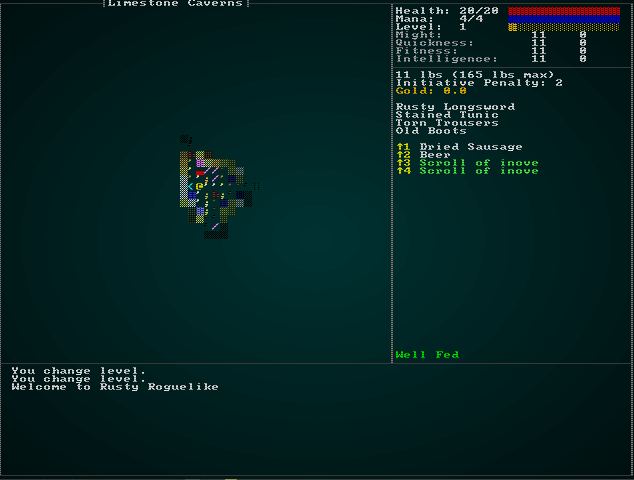
Clean Up
We should change the magical longsword's spawn weight back down to something reasonable, and make common longswords more frequent. In spawns.json:
{ "name" : "Longsword", "weight" : 2, "min_depth" : 3, "max_depth" : 100 },
{ "name" : "Longsword +1", "weight" : 1, "min_depth" : 3, "max_depth" : 100 },
Also, if you've given the character any free items in spawner.rs, go ahead and remove them (unless you want them to be ubiquitous)!
Tool-tips
We've still got an issue to handle. If you mouse-over an item, it displays its actual name - rather than its obfuscated name. Open up gui.rs, and we'll fix that. Fortunately, it's pretty easy now that we've built the name framework! We can remove names altogether from the ECS structures, and just pass the entity and ECS to the get_item_display_name to obtain a name for the entity:
#![allow(unused)] fn main() { fn draw_tooltips(ecs: &World, ctx : &mut Rltk) { use rltk::to_cp437; let (min_x, _max_x, min_y, _max_y) = camera::get_screen_bounds(ecs, ctx); let map = ecs.fetch::<Map>(); let positions = ecs.read_storage::<Position>(); let hidden = ecs.read_storage::<Hidden>(); let attributes = ecs.read_storage::<Attributes>(); let pools = ecs.read_storage::<Pools>(); let entities = ecs.entities(); let mouse_pos = ctx.mouse_pos(); let mut mouse_map_pos = mouse_pos; mouse_map_pos.0 += min_x - 1; mouse_map_pos.1 += min_y - 1; if mouse_pos.0 < 1 || mouse_pos.0 > 49 || mouse_pos.1 < 1 || mouse_pos.1 > 40 { return; } if mouse_map_pos.0 >= map.width-1 || mouse_map_pos.1 >= map.height-1 || mouse_map_pos.0 < 1 || mouse_map_pos.1 < 1 { return; } if !map.visible_tiles[map.xy_idx(mouse_map_pos.0, mouse_map_pos.1)] { return; } let mut tip_boxes : Vec<Tooltip> = Vec::new(); for (entity, position, _hidden) in (&entities, &positions, !&hidden).join() { if position.x == mouse_map_pos.0 && position.y == mouse_map_pos.1 { let mut tip = Tooltip::new(); tip.add(get_item_display_name(ecs, entity)); ... }
If you mouse-over things now, you'll see the obfuscated name. You could even use this to obfuscate NPC names if you feel like integrating spies into your game!
Information leakage via the log
There's another glaring problem: if you watch the log while you pickup or drop an item, it shows the item's real name! The issues all occur in inventory_system.rs, so we'll take our "outside the ECS" function from gui.rs and adapt it to work inside systems. Here's the function:
#![allow(unused)] fn main() { fn obfuscate_name( item: Entity, names: &ReadStorage::<Name>, magic_items : &ReadStorage::<MagicItem>, obfuscated_names : &ReadStorage::<ObfuscatedName>, dm : &MasterDungeonMap, ) -> String { if let Some(name) = names.get(item) { if magic_items.get(item).is_some() { if dm.identified_items.contains(&name.name) { name.name.clone() } else if let Some(obfuscated) = obfuscated_names.get(item) { obfuscated.name.clone() } else { "Unidentified magic item".to_string() } } else { name.name.clone() } } else { "Nameless item (bug)".to_string() } } }
Then we can change the ItemCollectionSystem to use it. There's a fair number of additional systems involved:
#![allow(unused)] fn main() { pub struct ItemCollectionSystem {} impl<'a> System<'a> for ItemCollectionSystem { #[allow(clippy::type_complexity)] type SystemData = ( ReadExpect<'a, Entity>, WriteExpect<'a, GameLog>, WriteStorage<'a, WantsToPickupItem>, WriteStorage<'a, Position>, ReadStorage<'a, Name>, WriteStorage<'a, InBackpack>, WriteStorage<'a, EquipmentChanged>, ReadStorage<'a, MagicItem>, ReadStorage<'a, ObfuscatedName>, ReadExpect<'a, MasterDungeonMap> ); fn run(&mut self, data : Self::SystemData) { let (player_entity, mut gamelog, mut wants_pickup, mut positions, names, mut backpack, mut dirty, magic_items, obfuscated_names, dm) = data; for pickup in wants_pickup.join() { positions.remove(pickup.item); backpack.insert(pickup.item, InBackpack{ owner: pickup.collected_by }).expect("Unable to insert backpack entry"); dirty.insert(pickup.collected_by, EquipmentChanged{}).expect("Unable to insert"); if pickup.collected_by == *player_entity { gamelog.entries.push( format!( "You pick up the {}.", obfuscate_name(pickup.item, &names, &magic_items, &obfuscated_names, &dm) ) ); } } wants_pickup.clear(); } } }
Likewise, we need to adjust the item dropping system:
#![allow(unused)] fn main() { pub struct ItemDropSystem {} impl<'a> System<'a> for ItemDropSystem { #[allow(clippy::type_complexity)] type SystemData = ( ReadExpect<'a, Entity>, WriteExpect<'a, GameLog>, Entities<'a>, WriteStorage<'a, WantsToDropItem>, ReadStorage<'a, Name>, WriteStorage<'a, Position>, WriteStorage<'a, InBackpack>, WriteStorage<'a, EquipmentChanged>, ReadStorage<'a, MagicItem>, ReadStorage<'a, ObfuscatedName>, ReadExpect<'a, MasterDungeonMap> ); fn run(&mut self, data : Self::SystemData) { let (player_entity, mut gamelog, entities, mut wants_drop, names, mut positions, mut backpack, mut dirty, magic_items, obfuscated_names, dm) = data; for (entity, to_drop) in (&entities, &wants_drop).join() { let mut dropper_pos : Position = Position{x:0, y:0}; { let dropped_pos = positions.get(entity).unwrap(); dropper_pos.x = dropped_pos.x; dropper_pos.y = dropped_pos.y; } positions.insert(to_drop.item, Position{ x : dropper_pos.x, y : dropper_pos.y }).expect("Unable to insert position"); backpack.remove(to_drop.item); dirty.insert(entity, EquipmentChanged{}).expect("Unable to insert"); if entity == *player_entity { gamelog.entries.push( format!( "You drop the {}.", obfuscate_name(to_drop.item, &names, &magic_items, &obfuscated_names, &dm) ) ); } } wants_drop.clear(); } } }
Fixing item colors
Another issue is that we've color coded various magical items. A sharp-eyed player could know that a "scroll of blah" is actually a fireball scroll because of the color! The solution is to go through spawns.json and make sure that items have the same color.
Wrap-Up
This gets us the basics of the item identification mini-game. We've not touched cursed items, yet - that's for a future chapter (after we clear up some issues with our item systems; more on that in the next chapter).
...
The source code for this chapter may be found here
Run this chapter's example with web assembly, in your browser (WebGL2 required)
Copyright (C) 2019, Herbert Wolverson.
